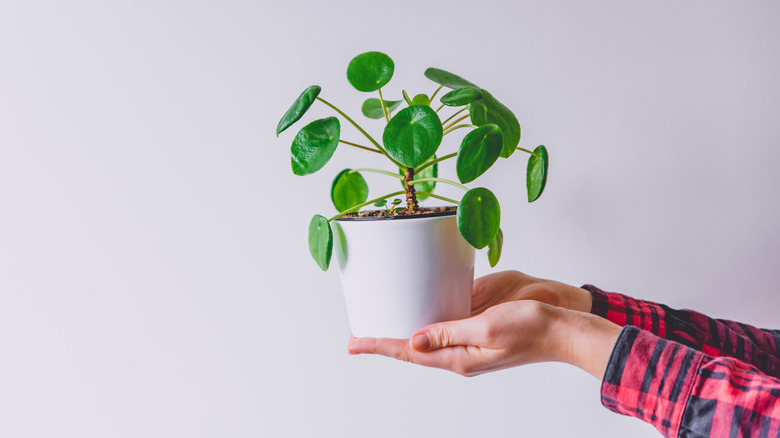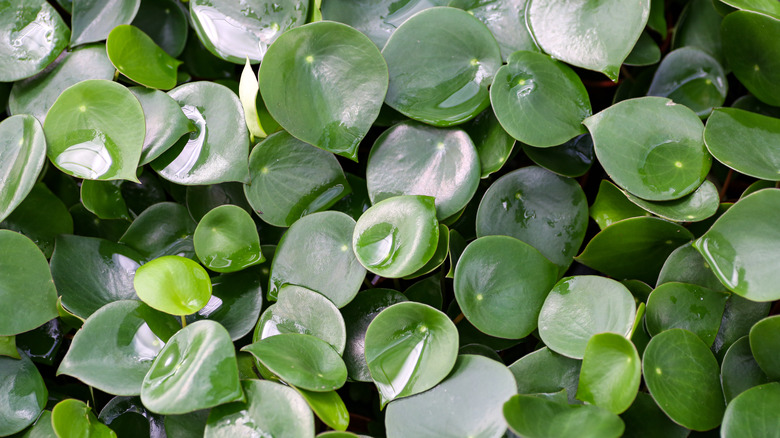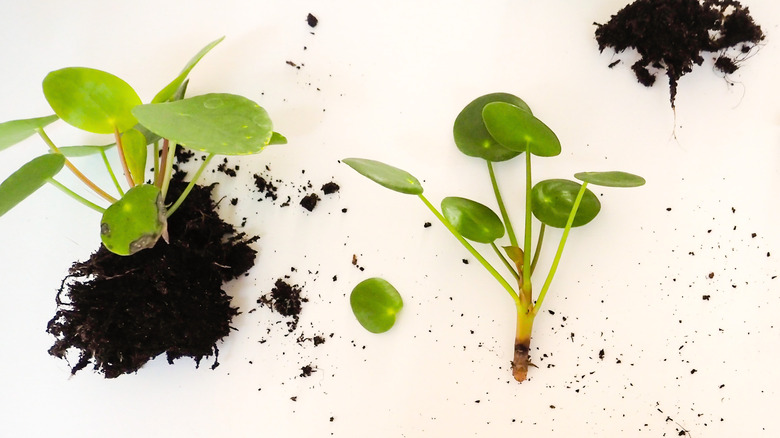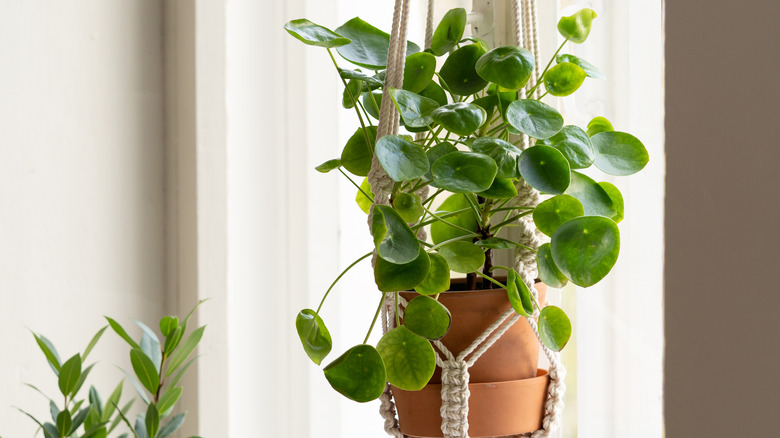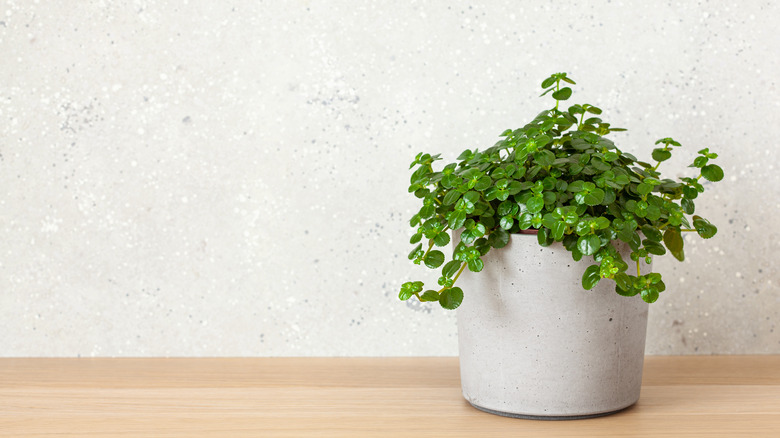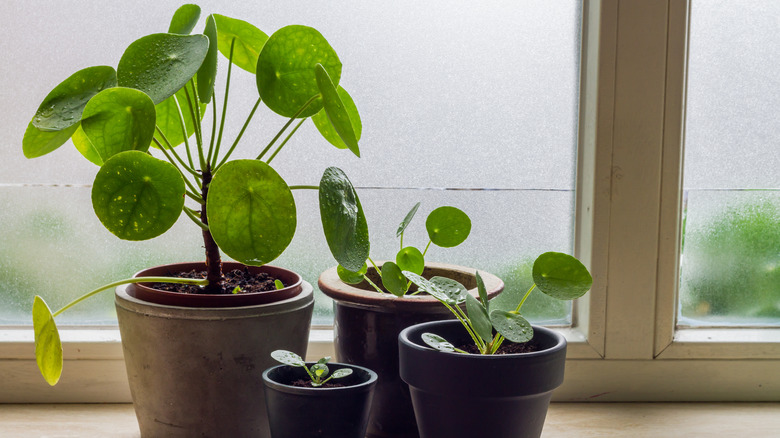Pilea Peperomioides: Everything You Should Know Before Planting
The pilea peperomioides, known most commonly as the Chinese money plant, is a low-maintenance, nontoxic, and unique houseplant. It is also known as the coin plant, pancake plant, or UFO plant due to its round, coin-like leaves (via The Spruce). Indoors, these plants are easy to care for and are a fun addition to your houseplant collection. Outdoors, these perennials will thrive in warmer climates year-round, or they can be brought out during the summer months in cooler environments. They also have the potential to sprout small, white flowers.
Pilea peperomioides is believed to have been popularized by a Norwegian missionary in the 1940s who brought cuttings back from Southern China and passed them out to friends; the plant then became popular in Europe, according to Apartment Therapy. This has led to pilea peperomioides also being called the missionary plant or friendship plant. This plant is a little hard to come by, but very easy to propagate and regrow.
How to use pilea peperomioides in garden
The pilea peperomioides is native to Southern China, and is on the same latitude as places such as Mexico and Saudi Arabia, says The Healthy Houseplant. As such, they are much more accustomed to warmer environments, growing best year-round in USDA zones 10 through 12. In the U.S., this includes Hawaii, Southern California, and Southern Florida. However, it is not uncommon to bring your indoor pilea peperomioides outside during warmer months, as long as temperatures don't dip below 50 degrees.
It is quite uncommon to grow the Chinese money plant outdoors in the U.S., since the conditions needed to keep it comfortable are a little specific and finicky. This plant prefers a more moist, tropical environment, the conditions of which are difficult to meet in most of the country. However, if you would like to see your pilea flower, it is a great idea to bring it out in warmer months. It is even suggested to expose your plant to cold winter air to encourage later blooms (via The Spruce).
How to grow pilea peperomioides
Propagating a pilea peperomioides is an incredibly easy process, and is one of the major appeals of this houseplant, per Pilea. A healthy plant will produce offshoots from its root system. Once the offshoots are a few inches tall, dig around the offshoot until you can see its root system. Using clean scissors or shears, cut a couple inches down the root.
You have your pilea cutting. Now what? There are a couple of options for rooting the offshoot. One option is to immediately plant the pilea peperomioides cutting in well-draining soil and allow it to root that way. Another option is to place the cutting in a clean glass or jar and fill it with water, allowing the offshoot to develop a more expansive root system before planting it. If you choose the latter, make sure the leaves aren't in contact with the water. It should take a few weeks or even a month for the roots to develop. Make sure to change the water every week or so. If you'd like to speed up the growth, add a couple pumps of a liquid fertilizer.
How to care for pilea peperomioides
The pilea peperomioides is incredibly easy to grow and care for, requiring very basic routine care, according to Plant Care for Beginners. Your pilea should be receiving medium to bright indirect light, preferably by an east or west facing window. South facing windows will provide plenty of light, but you should avoid putting pilea peperomioides in the direct rays of the sun, as it will burn the leaves. A north facing window is also less than ideal; pilea peperomioides will survive lower light conditions, but will become leggy and won't produce as many offshoots. Make sure to regularly rotate your plant, as its growth can become uneven.
Let your pilea dry out completely between waterings, and then water it thoroughly, making sure it has adequate drainage options. A good rule of thumb is to pick one day a week to water it. The leaves will begin to droop when underwatered. While this plant prefers moist conditions, average home humidity will suffice, so long as it's not placed near windows or air conditioners. Avoid misting, as it will leave water spots on the plant's leaves.
During the spring and summer, fertilize your pilea peperomioides monthly with your preference of houseplant fertilizer. Avoid fertilizing during its dormant season in the fall and winter. Apartment Therapy suggests wiping down your plant's larger leaves to avoid dust build up, and even occasionally showering your pilea.
Varieties of pilea peperomioides
While the pilea peperomioides is a popular choice for houseplant lovers, it is not the only variety of pilea. In fact, there are over 600 varieties in the pilea family, as noted by The Healthy Houseplant. Some of them make excellent additions to interior spaces, while other varieties are able to be grown outside, often as ground cover. Below are just a few of the more popular varieties.
-
Pilea Depressa — Also known as Baby Tears, this pilea has a lot of tiny leaves that look wonderful trailing from a hanging basket.
-
Pilea Mollis — This variety is often called Moon Valley, and sports fuzzy looking leaves with ridged edges.
-
Pilea Involucrata — A close relative of Moon Valley, this variety is often called the Friendship Plant, and shares the same unique leaf texture while standing out with its darker, bolder color.
-
Pilea Cadierei — This plant is often called the Aluminum Plant or Watermelon Pilea, and is distinguished by its silvery leaf variegation.
-
Pilea Nummulariifolia — The Creeping Charlie, as it's commonly called, is a gorgeous trailing house plant when planted in a hanging basket, and can also be used outdoors as ground cover.
How to repot pilea peperomioides
Due to its fast growing nature, it is recommended to repot your pilea peperomioides at least once a year in the spring. You will not need to upgrade its pot every year, but you should at least clean out and refresh old soil and remove offshoots. When considering if it's time to upgrade your pot size, Plant Care for Beginners says your pot should be a little smaller than the plant is wide. Most pot materials are fine, but just remember more porous materials, such as terracotta, will require more frequent watering.
The most important thing to remember when repotting your pilea is that it requires good drainage. This means both choosing a pot with adequate drainage holes, and a well draining soil. Peat moss, coco fiber, or perlite are all great soil additives to aid in better drainage, per Pilea.
To begin repotting your pilea, start by gently breaking up the old root system and getting rid of as much old soil as possible. It's at this stage that you can remove any offshoots. Add your pilea to its new pot, and add your soil. Water thoroughly and let drain.
